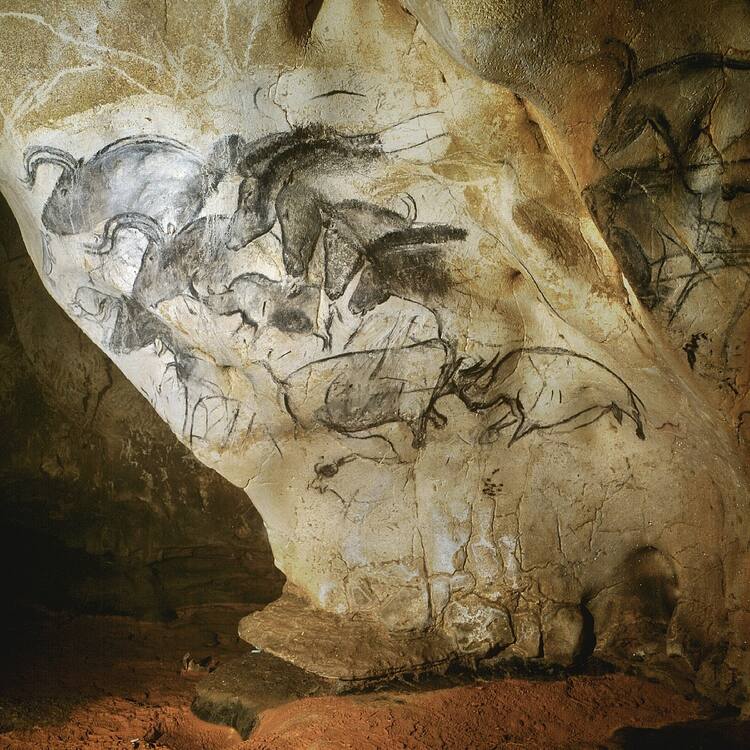Decorated Cave of Pont d’Arc, known as Grotte Chauvet-Pont d’Arc, Ardèche
Decorated Cave of Pont d’Arc, known as Grotte Chauvet-Pont d’Arc, Ardèche
Located in a limestone plateau of the Ardèche River in southern France, the property contains the earliest-known and best-preserved figurative drawings in the world, dating back as early as the Aurignacian period (30,000–32,000 BP), making it an exceptional testimony of prehistoric art. The cave was closed off by a rock fall approximately 20,000 years BP and remained sealed until its discovery in 1994, which helped to keep it in pristine condition. Over 1,000 images have so far been inventoried on its walls, combining a variety of anthropomorphic and animal motifs. Of exceptional aesthetic quality, they demonstrate a range of techniques including the skilful use of shading, combinations of paint and engraving, anatomical precision, three-dimensionality and movement. They include several dangerous animal species difficult to observe at that time, such as mammoth, bear, cave lion, rhino, bison and auroch, as well as 4,000 inventoried remains of prehistoric fauna and a variety of human footprints.
Description is available under license CC-BY-SA IGO 3.0
Grotte ornée du Pont-d’Arc, dite Grotte Chauvet-Pont-d’Arc, Ardèche
Située dans un plateau calcaire traversé par les méandres de la rivière Ardèche, au sud de la France, la grotte recèle les plus anciennes peintures connues à ce jour (période de l’aurignacien : entre 30 000 et 32 000 av. J.-C.). Cette grotte exceptionnelle qui témoigne de l’art préhistorique a été fermée par un éboulement il y a environ 20 000 ans BP et elle est restée scellée jusqu’à sa redécouverte en 1994, ce qui a permis de la conserver de façon exceptionnelle. Plus de 1 000 peintures, aux motifs anthropomorphes ou animaliers, ont été inventoriées sur ses murs. Leur qualité esthétique exceptionnelle témoigne d’une large gamme de techniques, notamment la maîtrise de l'estompe, la combinaison peinture-gravure, la précision anatomique, la représentation tridimensionnelle et du mouvement. On y trouve notamment des représentations d’espèces dangereuses, difficiles à observer pour les hommes de l’époque (mammouths, ours, lions des cavernes, rhinocéros, bisons, aurochs), plus de 4 000 restes de la faune du paléolithique et diverses empreintes de pas humains.
Description is available under license CC-BY-SA IGO 3.0
Gruta ornamentada de Pont d’Arc, denominada Gruta Chauvet-Pont d’Arc (Departamento del Ardèche, Francia)
En este sitio, situado al sur de Francia, en una meseta calcárea del río Ardèche, se hallan los dibujos figurativos más antiguos y mejor conservados del mundo. Realizados en el Periodo Auriñaciense (esto es, entre 30.000 y 32.000 años atrás), estos dibujos constituyen un testimonio excepcional del arte prehistórico. Hace unos 20.000 años, un desprendimiento de rocas cerró herméticamente la entrada de la gruta hasta su hallazgo en 1994, lo cual permitió que se conservara en su estado primigenio. Hasta la fecha se han podido catalogar más de 1.000 imágenes pintadas en sus paredes con una gran variedad de motivos animales y antropomórficos. Su calidad estética es excepcional y su ejecución pone de manifiesto el dominio de toda una serie de técnicas: pericia en el uso de los colores, combinación de la pintura y el grabado, precisión anatómica, tridimensionalidad y sentido del movimiento. Las imágenes muestran diversas especies animales peligrosas y difíciles de observar en esa época (mamuts, osos, gatos monteses, rinocerontes, bisontes y uros), y también se han hallado unos 4.000 restos catalogados de fauna prehistórica y un variado conjunto de huellas humanas.
source: UNESCO/CPE
Description is available under license CC-BY-SA IGO 3.0
アルデッシュ ショーヴェ・ポンダルク洞窟壁画
フランス南東部アルデッシュ県の石灰岩台地に位置する約8500㎡のショーヴェ洞窟では、3万年前以上から描かれた世界最古級の壁画が1000点以上も見られる。この洞窟は約2万年前の落石によって閉ざされていたため、1994年に発見された際にもきわめて良好な保存状態を保っていた。マンモスやクマ、ヤマネコ、サイ、バイソンなどが描かれた壁画は解剖学的にも精度が高く、有史以前の人類と動物の関わりや環境を知る手がかりとなると同時に、人類最古の天才的な絵画表現ならびに、その証拠として高い価値を持つ。source: NFUAJ
Beschilderde grot van Pont d'Arc (Grotte Chauvet-Pont d'Arc), Ardèche
De beschilderde grot van Pont d'Arc – bekend als Grotte Chauvet-Pont d'Arc – ligt in een kalkstenen plateau van de rivier de Ardèche in Zuid-Frankrijk. De grot bevat de vroegst bekende en best bewaarde figuratieve tekeningen ter wereld, daterend uit het Aurignacien (30.000 tot 32.000 voor Christus). Daarmee is het een bijzonder voorbeeld van prehistorische kunst. Ongeveer 20.000 jaar voor Christus werd de grot afgesloten door een vallende steen en bleef verzegeld tot de ontdekking ervan in 1994. Hierdoor bleef de grot in ongerepte staat. Tot nu toe zijn er op de muren meer dan 1000 afbeeldingen ontdekt die antropomorfe en dierlijke motieven met elkaar verbinden. Ze zijn van buitengewone esthetische kwaliteit en tonen diverse technieken waaronder kundig kleurgebruik, het combineren van verf en gravure, anatomische precisie, driedimensionaliteit en beweging. De grotschilderingen tonen verschillende gevaarlijke diersoorten die in die tijd moeilijk waar te nemen waren, zoals mammoeten, beren, wilde katten, neushoorns, bizons en oerossen. In de grot vond men ook 4000 overblijfselen van prehistorische fauna en diverse menselijke voetafdrukken.
Source: unesco.nl
Outstanding Universal Value
Brief synthesis
The decorated cave of Pont d’Arc, known as Grotte Chauvet-Pont d’Arc is located in a limestone plateau of the meandering Ardèche River in southern France, and extends to an area of approximately 8,500 square meters. It contains the earliest known pictorial drawings, carbon-dated to as early as the Aurignacian period (30,000 to 32,000 BP). The cave was closed off by a rock fall approximately 20,000 years BP and remained sealed until its rediscovery in 1994. It contains more than 1,000 drawings, predominantly of animals, including several dangerous species, as well as a large number of archaeological and Palaeolithic vestiges.
The cave contains the best-preserved expressions of artistic creation of the Aurignacian people, constituting an exceptional testimony of prehistoric cave art. In addition to the anthropomorphic depictions, the zoomorphic drawings illustrate an unusual selection of animals, which were difficult to observe or approach at the time. Some of these are uniquely illustrated in Grotte Chauvet. As a result of the extremely stable interior climate over millennia, as well as the absence of natural damaging processes, the drawings and paintings have been preserved in a pristine state of conservation and in exceptional completeness.
Criterion (i): The decorated cave of Pont d’Arc, known as Grotte Chauvet-Pont d’Arc contains the first known expressions of human artistic genius and more than 1,000 drawings of anthropomorphic and zoomorphic motifs of exceptional aesthetic quality have been inventoried. These form a remarkable expression of early human artistic creation of grand excellence and variety, both in motifs and in techniques. The artistic quality is underlined by the skilful use of colours, combinations of paint and engravings, the precision in anatomical representation and the ability to give an impression of volumes and movements.
Criterion (iii): The decorated cave of Pont d’Arc, known as Grotte Chauvet-Pont d’Arc bears a unique and exceptionally well-preserved testimony to the cultural and artistic tradition of the Aurignacian people and to the early development of creative human activity in general. The cave’s seclusion for more than 20 millennia has transmitted an unparalleled testimony of early Aurignacian art, free of post-Aurignacian human intervention or disturbances. The archaeological and paleontological evidence in the cave illustrates like no other cave of the Early Upper Palaeolithic period, the frequentation of caves for cultural and ritual practices.
Integrity
The nominated property comprises the entire subterranean space of the cave of approximately 8,500 square meters and all structurally relevant parts of the limestone plateau above the cave as well as its entrance situation and immediate surroundings. These spaces contain all the attributes of Outstanding Universal Value and the property is of adequate size. Strict preventive conservation policies including access restrictions have allowed for the maintenance of an almost identical situation to the time of discovery. These access restrictions and the continuous monitoring of the climatic conditions will be key factors for the preservation of integrity of the property and for averting potential dangers of human impact.
Authenticity
The authenticity of the property can be demonstrated by its pristine condition and state of conservation, having been sealed off for 23,000 years and carefully treated and access-restricted since its rediscovery. The dating of the finds and drawings has been confirmed by C14 analysis as between 32,000 and 30,000 years BP, and the materials, designs, drawing techniques and traces of workmanship date back to this time. The rock art as well as the archaeological and paleontological vestiges are free of human impact or alterations. The only modification is the installation of completely-reversible, stainless steel bridging elements to allow for access to parts of the cave whilst preventing disturbance of floor traces or finds.
Protection and management requirements
The decorated cave of Pont d’Arc, known as Grotte Chauvet-Pont d’Arc is protected at the highest national level as a historic monument. Likewise, the buffer zone benefits from the highest level of national protection since early 2013. The buffer zone accordingly will not permit future development.
The focus of management is the implementation of a preventive conservation strategy based on constant monitoring and non-intervention. Several monitoring systems have been installed in the cave which form an integral part of these preventive conservation efforts. Any changes in relative humidity and/or the air composition inside the cave may have severe effects on the condition of the drawings and paintings. It is due to this risk that the cave will not be open to the general public, but also that future visits of experts, researchers and conservators will need to be restricted to the absolute minimum necessary. Despite the delicateness of paintings and drawings, no conservation activities have been carried out in the cave and it is intended to retain all paintings and drawings in the fragile but pristine condition in which they were discovered.
The management authorities have implemented a management plan (2012-16), based on strategic objectives, activity fields and concrete actions, which are planned with time frames, institutional responsibilities, budget requirements and quality assurance indicators. The latter will allow for full quality assurance after the cycle of implementation in 2016, following which the management plan will have to be revised for future management processes.
After it became clear that the cave would never be accessible to the general public, the idea of a facsimile reconstruction to provide interpretation and presentation facilities emerged. The Grand Projet Espace de Restitution de la Grotte Chauvet (ERGC) was established, with the aim of creating a facsimile reconstruction of the cave with its paintings and drawings, and a discovery and interpretation area to attract visitors.


